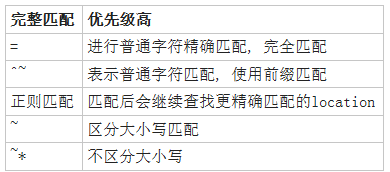1.Server优先级
Nginx多个相同Server_name优先级
1.环境准备
[root@nginx ~]# mkdir /soft/code{1..3} -p
[root@nginx ~]# for i in {1..3};do echo "<h1>Code $i</h1>" > /soft/code"$i"/index.html;done2.准备多份相同Nginx配置文件
[root@Nginx conf.d]# ll
总用量 12
-rw-r--r-- 1 root root 123 4月 19 19:08 testserver1.conf
-rw-r--r-- 1 root root 123 4月 19 19:09 testserver2.conf
-rw-r--r-- 1 root root 123 4月 19 19:09 testserver3.conf
//内容如下
[root@Nginx conf.d]# cat testserver{1..3}.conf
server {
listen 80;
server_name testserver1 192.168.69.113;
location / {
root /soft/code1;
index index.html;
}
}
server {
listen 80;
server_name testserver2 192.168.69.113;
location / {
root /soft/code2;
index index.html;
}
}
server {
listen 80;
server_name testserver3 192.168.69.113;
location / {
root /soft/code3;
index index.html;
}
}
//检测语法
[root@Nginx conf.d]# nginx -t
nginx: [warn] conflicting server name "192.168.69.113" on 0.0.0.0:80, ignored
nginx: [warn] conflicting server name "192.168.69.113" on 0.0.0.0:80, ignored
nginx: the configuration file /etc/nginx/nginx.conf syntax is ok
nginx: configuration file /etc/nginx/nginx.conf test is successful
//重启Nginx
[root@Nginx conf.d]# nginx -t3.测试访问效果
[root@Nginx conf.d]# curl 192.168.69.113
<h1>Code 1</h1>
[root@Nginx conf.d]# mv testserver1.conf testserver5.conf
[root@Nginx conf.d]# nginx -s reload
[root@Nginx conf.d]# curl 192.168.69.113
<h1>Code 2</h1>2.location优先级
一个server出现多个location
1.实例准备
[root@Nginx conf.d]# cat testserver.conf
server {
listen 80;
server_name 192.168.69.113;
root /soft;
index index.html;
location = /code1/ {
rewrite ^(.*)$ /code1/index.html break;
}
location ~ /code* {
rewrite ^(.*)$ /code3/index.html break;
}
location ^~ /code {
rewrite ^(.*)$ /code2/index.html break;
}
}2.测试效果
[root@Nginx conf.d]# curl http://192.168.69.113/code1/
<h1>Code 1</h1>
//注释掉精确匹配=, 重启Nginx
[root@Nginx ~]# curl http://192.168.69.113/code1/
<h1>Code 2</h1>
//注释掉^~, 重启Nginx
[root@Nginx ~]# curl http://192.168.69.113/code1/
<h1>Code 3</h1>3.try_files的使用
nginx的try_files按顺序检查文件是否存在
location /{
try_files $uri $uri/ /index.php;
}
#1.检查用户请求的uri内容是否存在本地,存在则解析
#2.将请求加/, 类似于重定向处理
#3.最后交给index.php处理 1.演示环境准备
[root@Nginx ~]# echo "Try-Page" > /soft/code/index.html
[root@Nginx ~]# echo "Tomcat-Page" > /soft/app/apache-tomcat-9.0.7/webapps/ROOT/index.html
//启动tomcat
[root@Nginx ~]# sh /soft/app/apache-tomcat-9.0.7/bin/startup.sh
//检查tomcat端口
[root@Nginx ~]# netstat -lntp|grep 8080
tcp6 0 0 :::8080 :::* LISTEN 104952/java 2.配置Nginx的tryfiles
[root@Nginx ~]# cat /etc/nginx/conf.d/try.conf
server {
listen 80;
server_name 192.168.69.113;
root /soft/code;
index index.html;
location / {
try_files $uri @java_page;
}
location @java_page {
proxy_pass http://127.0.0.1:8080;
}
}
//重启Nginx
[root@Nginx ~]# nginx -s reload3.测试tryfiles
[root@Nginx ~]# curl http://192.168.69.113/index.html
Try-Page
//将/soft/code/index.html文件移走
[root@Nginx ~]# mv /soft/code/{index.html,index.html_bak}
//发现由Tomcat吐回了请求
[root@Nginx ~]# curl http://192.168.69.113/index.html
Tomcat-Page4.alias与root区别
root路径配置
[root@Nginx ~]# mkdir /local_path/code/request_path/code/ -p
[root@Nginx ~]# echo "Root" > /local_path/code/request_path/code/index.html
//Nginx的root配置
[root@Nginx ~]# cat /etc/nginx/conf.d/root.conf
server {
listen 80;
index index.html;
location /request_path/code/ {
root /local_path/code/;
}
}
//请求测试
[root@Nginx conf.d]# curl http://192.168.69.113/request_path/code/index.html
Root
//实际请求本地文件路径为
/local_path/code/'request_path/code'/index.html
alias路径配置
[root@Nginx ~]# mkdir /local_path/code/request_path/code/ -p
[root@Nginx ~]# echo "Alias" > /local_path/code/index.html
//配置文件
[root@Nginx ~]# cat /etc/nginx/conf.d/alias.conf
server {
listen 80;
index index.html;
location /request_path/code/ {
alias /local_path/code/;
}
}
//测试访问
[root@Nginx ~]# curl http://192.168.69.113/request_path/code/index.html
Alias
//实际访问本地路径
/local_path/code/'index.html'5.获取用户真实IP
Nginx传递用户的真实IP地址
$remote_addr 只能获取到最近一台服务器访问IP
x_forwarded_for 头部信息容易被篡改6.常见HTTP状态码
200 正常请求
301 永久跳转
302 临时跳转
400 请求参数错误
401 账户密码错误(authorization required)
403 权限被拒绝(forbidden)
404 文件没找到(Not Found)
413 用户上传文件大小限制(Request Entity Too Large)
502 后端服务无响应(boy gateway)
504 后端服务执行超时(Gateway Time-out)7.网站访问原理
网站相关术语
如果一栋大厦里所有工作人员通过1个IP公网接口上网, 总共100个设备, 当所有人同时请求一个网站, 并且刷新了5次, 那么请求pv、ip、uv分别是多少
pv:页面浏览量 500
uv:唯一设备100
ip:唯一出口 1
• 1.DNS流程
○ 1.查询本地Hosts
○ 2.请求本地localDNS
○ 3.返回对应的IP
• 2.HTTP连接
○ 1.建立TCP三次握手,发送请求内容, 请求头、请求的行、请求的主体
○ 2.将请求传递给负载均衡, 负载均衡做对应的调度
○ 3.如果请求的是静态页面, 那么调度至对应的静态集群组即可
○ 4.如果请求的是动态页面, 将请求调度至动态集群组
§ 1.如果仅仅是请求页面, 可能会经过Opcache缓存返回
§ 2.如果请求页面需要查询数据库, 或者是往数据库插入内容
§ 3.检查对应的操作是查询还是写入, 如果是查询数据库
§ 4.检查查询的内容是否有被缓存, 如有缓存则返回
§ 5.检查查询语句, 将查询结果返回
§ 6.内存缓存Redis缓存对应的查询结果
§ 7.返回对应客户端请求的内容至于WEB节点
§ 8.WEB节点收到请求后返回内容至负载均衡
§ 9.负载均衡返回客户端内容, TCP四次断开
• 3.HTTP断开连接面试时需注意:
1.按照分层结构
CDN层->负载层->WEB层->存储层->缓存层->数据库层
同时需要注意, 每一层都有对应的缓存机制
8.Nginx优化方案
Nginx优化
1.gzip压缩
2.expires静态文件缓存
3.调整网络IO模型,调整Nginx worker进程的最大连接数
5.隐藏Nginx名称和版本号
6.配置防盗链,防止资源被盗用
7.禁止通过IP地址访问,禁止恶意域名解析,只允许域名访问
8.防DDOS、cc攻击, 限制单IP并发请求连接
9.配置错误页面,根据错误代码指定网页反馈用户
10.限制上传资源目录被程序访问,防止木马入侵系统
11.Nginx加密传输优化9.Nginx架构总结
基于Nginx中间件的架构
• 1.了解需求(定义Nginx在服务体系中的角色)
○ 静态资源服务的功能设计
§ 类型分类(视频、图片、html)
§ 浏览器缓存
§ 防盗链
§ 流量限制
§ 防资源盗用
§ 压缩(压缩模式, 压缩比例, 压缩类型)
○ 代理服务
§ 协议类型
§ 正向代理
§ 反向代理
§ 负载均衡
§ 代理缓存
§ 头信息处理
§ Proxy_Pass
§ LNMP
§ 动静分离
• 2.设计评估
○ 硬件 CPU、内存、磁盘
○ 系统(用户权限、日志目录存放)
○ 代理服务/负载均衡 (CPU、内存)
○ 静态资源服务(硬盘容量、硬盘转速)
○ 动态资源服务(硬盘转速、读写效率)
○ 缓存资源服务(SSD固态)
• 3.配置注意事项
○ 合理配置
○ 了解原理
§ http协议原理
§ http状态原理
§ 操作系统原理
○ 关注日志
§ 日志是否有打开
§ 是否有对应请求
§ 请求状态码信息符合
§ 错误日志信息吐出来
§ 错误日志内容和含义
文档更新时间: 2019-07-09 12:57 作者:李延召
